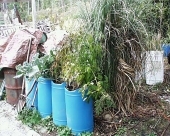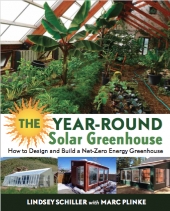You described the challenge with greenhouses perfectly -- way too hot, way to cold.... A big reason why the dinky greenhouse versions don't work very well as year-round growing structures.
To combat overheating, I would add fans (though you have to get electricity to it). For growing in the summer, perhaps you could remove one of the panels of glass for more airflow?
To combat freezing at night, I would try to seal it up as much as possible by caulking the seams. I am guessing they leak like a sieve which won't do much for retaining warmer temperatures at night.
Then, yes, thermal mass is a great idea. I would consider water barrels if you can fit them (perhaps under growing benches?). Just wrote a blog on water barrels in greenhouses if you want to see some pics of others (though obviously you don't have to go as far as a water wall; simple jugs can help a bit).
http://www.ceresgs.com/tips-on-using-water-barrels-in-a-solar-greenhouse/






